The harrowing truth about tiger farming in southeast Asia
Although widely reported to have been shut down, Terrence McCoy discovers first-hand that the appalling and tragic trade in wildlife is alive and well in Laos
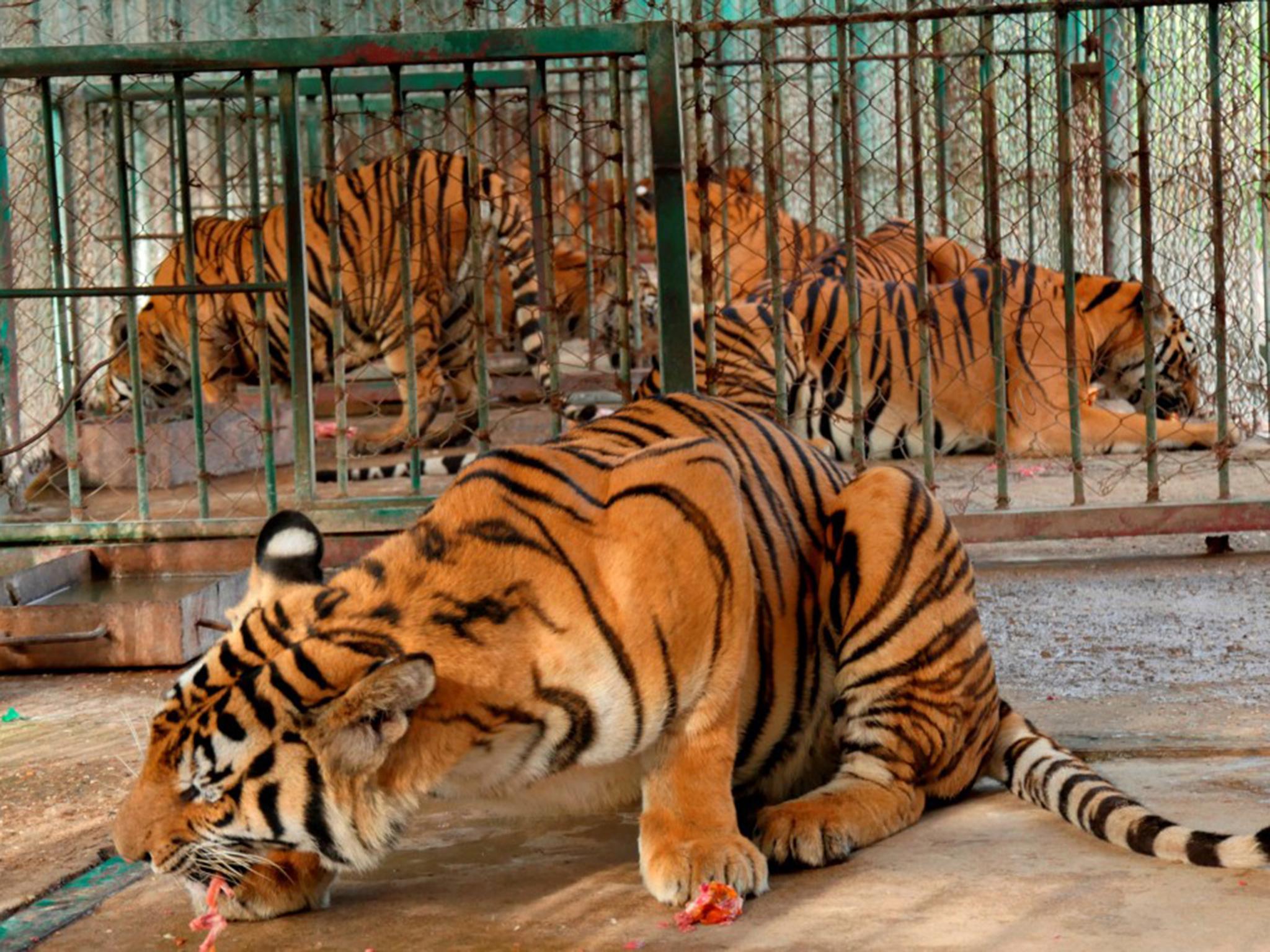
Your support helps us to tell the story
From reproductive rights to climate change to Big Tech, The Independent is on the ground when the story is developing. Whether it's investigating the financials of Elon Musk's pro-Trump PAC or producing our latest documentary, 'The A Word', which shines a light on the American women fighting for reproductive rights, we know how important it is to parse out the facts from the messaging.
At such a critical moment in US history, we need reporters on the ground. Your donation allows us to keep sending journalists to speak to both sides of the story.
The Independent is trusted by Americans across the entire political spectrum. And unlike many other quality news outlets, we choose not to lock Americans out of our reporting and analysis with paywalls. We believe quality journalism should be available to everyone, paid for by those who can afford it.
Your support makes all the difference.He was up there somewhere, at the top of the hill, the man Karl Ammann had come to see. It would soon be night. The forest was all shadows and sounds. Ammann had driven across the country to reach this remote river village, and now he was finally here, looking to the top of the hill, ready to confront the person he believed had murdered more tigers than anyone in Laos. In the distance, he could hear them: dozens of tigers roaring.
For nearly five years, Ammann, 70, a Swiss counter-trafficking conservationist, had tracked the tiger butcher, a man named Nikhom Keovised. He had placed hidden cameras inside what had once been the largest tiger farm in southeast Asia, an illegal operation where tigers had been raised to one end – slaughter – and where the man doing the slaughtering had been Nikhom. And he had listened to Nikhom describe it all in his own words: “Use the anesthetic,” he had said. “Then just cut the neck.” Then “peel its skin”.
Now Nikhom had established himself here, in this half-splash of civilisation near the Vietnam border, where he’d just opened what his boss – considered one of the nation’s biggest wildlife traffickers – described as a zoo, but what Ammann suspected was a front for selling tigers.
Ammann knew the risks. He was in the country without permission to investigate its wildlife practices. He was unarmed. Neither Nikhom nor his boss, who didn’t respond to repeated requests for comment, had ever been charged with anything, let alone arrested. If discovered, the equipment Ammann had with him – the drone, the hidden cameras, the satellite images of the country’s tiger farms – would immediately unravel his cover story, that he was a tourist here on a lark.
But he could already feel the familiar intensity. It had driven him to undertake dozens of risky, self-funded investigations, pushed him to the fringes of the conservation community and caused even friends to describe him as obsessive, if not a little crazy. He couldn’t stop. Those responsible had to be held to account. Species by species, the world is rapidly undergoing an ecological transformation, becoming barely recognisable from the planet it was a few centuries ago. It is a world reckoning with an end of wildness, where humanity and domesticated animals account for almost all mammal biomass, and the tiger, whose captive population now dwarfs its numbers in the wild, is on the verge of becoming a fully industrialised commodity.
For 10 days late last year, I joined Ammann on an undercover journey to the core of the modern tiger economy to determine whether Laos, a global hub of wildlife trafficking, had fulfilled its promises since 2016 to stamp out the wildlife trade. The trip had been dangerous from the beginning, and then got riskier, and now we’d arrived to this hill, where, above, the tigers were becoming louder.
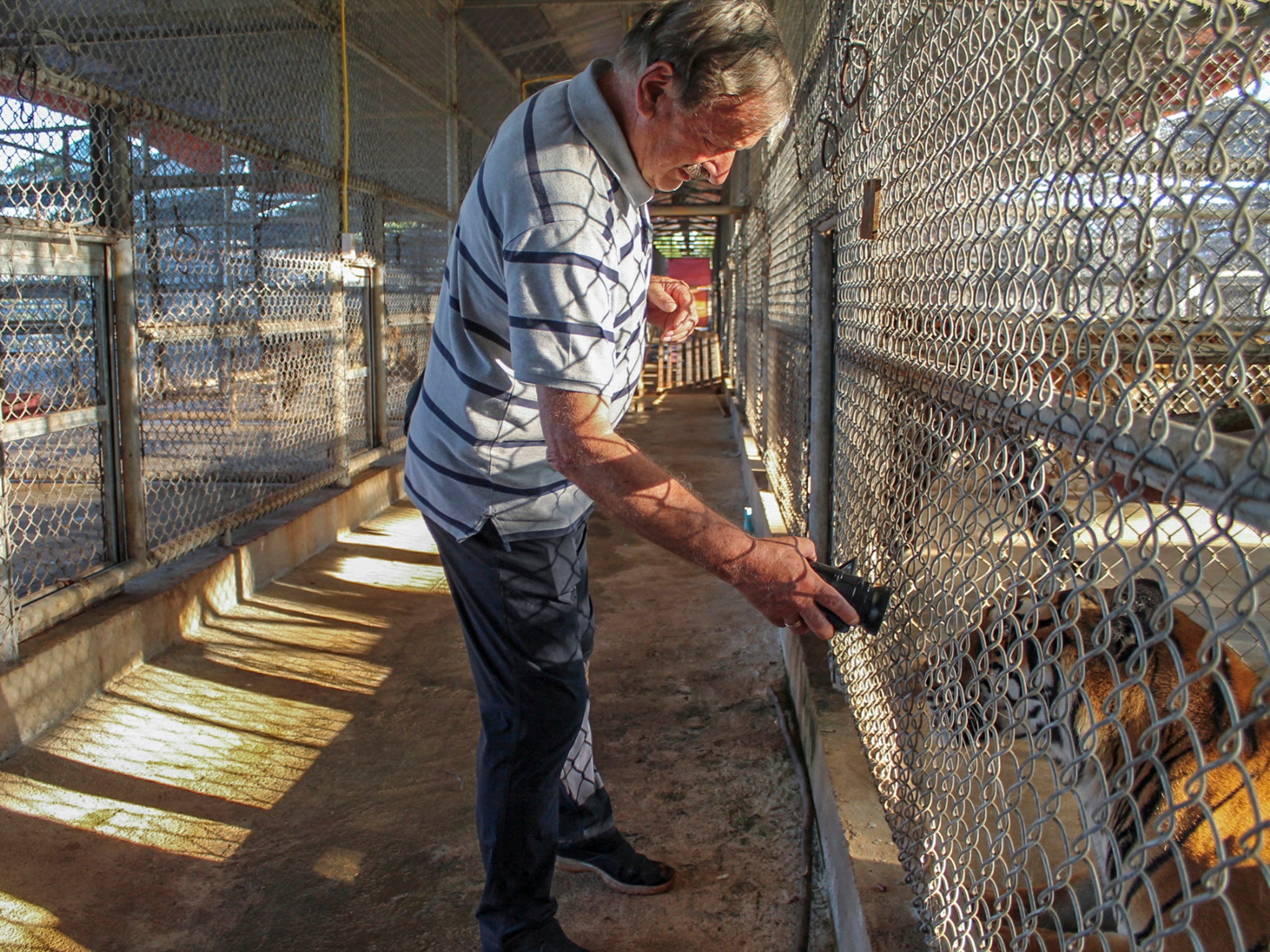
They were hungry, Ammann announced. It would soon be time to feed them. He slung his camera over his shoulder and started up the hill, in search of tigers and their warden.
Over the past century or so, the tiger population has plunged in the wild, dropping from an estimated 100,000 to fewer than 4,000, while the number in captivity had exploded to more than 12,500. Nowhere else was the animal’s commodification more complete than in tiger farming, where it is raised, butchered for parts and sold for tens of thousands of dollars. And nowhere else had these farms operated with greater impunity than in Laos, an obscure communist nation whose own wild tigers have nearly all been killed. Ammann was one of the few people who’d seen inside the country’s farms.
When I’d first spoken to him in June of last year, I’d expected to find someone who was, if not optimistic, then at least hopeful. In a smattering of countries in south Asia, the tiger’s population appeared to be stabilising, even as it cratered elsewhere. And since 2016, international authorities and some conservationists had applauded Laos, home to some of Asia’s biggest wildlife traffickers, as it announced overhauls to finally clean up the trade.
Shops trading in bones and wildlife merchandise were to cease. All three of the country’s illegal tiger farms, which stored 700 tigers, were ordered to stop farming and convert into zoos and conservation centres. No new facilities breeding endangered wildlife for commercial purposes would open. From the outside, things seemed to be getting a bit better. Even Prince William had reportedly taken up the cause.
But Ammann was neither optimistic nor hopeful, and, if anything, seemed offended by the suggestion. In our first substantive phone conversation, he immediately plunged into the arcana of tiger farming in Laos, citing operational tiger farms and going on and on about “lip service” and how we were being taken for “bloody fools”. While Ammann vented, I searched for images of him. He looked the same in every one: mustachioed and grimacing, an expression of the frustration and futility in his voice.
“They all want hope and happy endings,” he said of producers and audiences who ignored his documentaries, despite their findings. “And I don’t see any happy endings. I can’t create fiction from what I see as fact.”
We ended the phone call, with him promising to send me some photographs and documents from a trip he’d just taken to Laos to work on a documentary about tiger trafficking. I felt dazed. Who was that guy? And if he didn’t feel there was any hope, why did he assume so much risk going into some of the world’s most remote forests, without institutional support or funding, to document the destruction?
From then on, in interviews with conservationists about tiger trafficking, I saved a few questions for the end: Just what do you think of Ammann? Almost everyone I asked immediately knew who Ammann was and said his findings were sound. He could be trusted – but. But what?
“He takes a lot of risks,” Steve Galster, a counter-trafficking expert in Bangkok, said after a long pause.
“A difficult character,” said Crawford Allan, a senior director at World Wildlife Fund (WWF). Ammann had been kicked out of an international conservation meeting for aggressively confronting officials and was known to send environmentalists notes denigrating their work after they’d just trumpeted it in press releases.
“A bit of a kook who gets results,” a law enforcement consultant in Laos, who spoke on the condition of anonymity, called him
This sliver of Bokeo Province is controlled by a transnational criminal operation that engages in an array of horrendous illicit activities, including child prostitution and human, drug and wildlife trafficking
Ammann had sent me some of those results. I pulled up the documents and photographs on my computer, and immediately recoiled. The first one was of a diseased tiger in a claustrophobic cage – mangy, eyes desperate, death coming. The next showed seven tigers eating bloody, raw chicken off the ground, clustered in a line of cramped cages.
Two more were from high above, where Ammann had flown a drone to capture images of two massive tiger farms, showing the animals in cage after cage. He included a 3,700-word missive he’d dispatched to the UN commission charged with regulating the wildlife trade, the Convention on International Trade in Endangered Species of Wild Fauna and Flora (Cites), accusing the organisation of being “a big part of the problem”. He’d sent the same letter to a European Parliament official, attaching this comment: “So you cannot say you did not know. My motto for doing this.”
I called Ammann, who was at home in his estate at the base of Mount Kenya, where he keeps as “dependents” two orphaned chimpanzees. I asked whether he was planning on going to Laos again. He said he was – and it would be before year’s end. In the coming weeks, in fact, he’d have the itinerary all planned out. This time, he hoped to take his investigation even further, stepping out from behind the hidden cameras to personally meet those who’d profited from the death of the tiger. “Why don’t you come,” he asked, “and see for yourself?”
We drove into the night, passing miles of undeveloped countryside, until a city sprang out of the blackness like a vision. Lexuses and Mercedes wheeled down its streets with license plates from all over China. Big hotels blinked with green and red lights. People swarmed around a large casino with a crown of gold at the town’s centre.
Known as the Golden Triangle Special Economic Zone, this sliver of Bokeo Province is controlled by a transnational criminal operation that “engages in an array of horrendous illicit activities”, including child prostitution and human, drug and wildlife trafficking, according to the US Treasury Department, which last year imposed sanctions on the network. “Sin city”, the London-based Environmental Investigation Agency, a non-governmental organisation, called the zone in a 2015 report – a “lawless playground” where an exclusive clientele of Chinese tourists could buy tiger parts in shops and eat tiger meat at restaurants. Just about the only Lao element of the town was geography. Clocks here were set to Beijing time, business was done in renminbi, and the dominant language was Mandarin.
On our first morning here, I could tell Ammann was already exasperated. His driver was not going fast enough, no matter how many times Ammann told him to pick it up. His computer had stopped working. The hotel where we’d spent the night before – the only one that still took Western guests following the US sanctions – had just told us to clear out. And now Chan was running late.
“Come on, Grace,” he said, waiting outside the hotel for her.
“Come on, Grace,” he said, less than a minute later.
“We’ve got to go,” he said again.
“Tell her to come,” he finally snapped, directing his Lao guide to go get her.
Chan finally got into the van, and Ammann told the driver to get moving.
He knew how he sometimes sounded, but there was no time for niceties, not while the world was committing suicide. In conversations, he frequently brought up environmental studies he’d just read, all of them apparently grim. Between 1970 and 2014, vertebrate populations dropped in size by an average of 60 per cent. One million plant and animal species now face extinction. The planet could soon lose 60 per cent of primate species, according to the peer-reviewed journal, Science Advances, noting how bush-meat hunting had sped their demise – a revelation that, to Ammann, wasn’t a revelation at all. It was his origin story.
In 1988, Ammann was in a long boat chugging up the Congo River in what was then Zaire. By then, he’d already spent two decades in Africa, where he had worked as a hotelier and photographer, eventually becoming wealthy opening and selling an ecotourism camp in Kenya’s Maasai Mara National Reserve. But along the river’s banks, he saw an Africa he didn’t know. Hundreds of slaughtered primates were strewn near the water’s edge, awaiting transport to nearby markets to be sold as bush meat. Deforestation had provided hunters with access to animals previously protected by dense jungle, giving rise to an underground economy.
The bush-meat hunts, the markets, the outrage he’d felt at their discovery: It soon consumed him. In the early 1990s, at a time when little was known about the bush-meat trade, he went to remote merchants and logging encampments, looking for apes orphaned by bush-meat hunters, and returned with gruesome images that few could stomach. Decapitated gorillas. Charbroiled monkeys. Butchered chimpanzees. His photography blurred into activism. He published books, lobbied governments, led international petitions against wildlife slaughter and took nearly every media opportunity that came his way.
He described it all as graphically as he could, hoping to shock people into action. “Up to their elbows in blood,” he said of bush-meat hunters in one 1995 newspaper interview. It was “98.5 cannibalism” to eat chimps, he said in another. “Maybe I’ve become too extreme,” he confessed in one more, and many conservationists then agreed.
Jane Goodall, the renowned chimpanzee conservationist, said he was too aggressive, and he said she wasn’t aggressive enough. Other conservationists accused him of “cultural imperialism”, and he countered that they worried more about fundraising than truth.
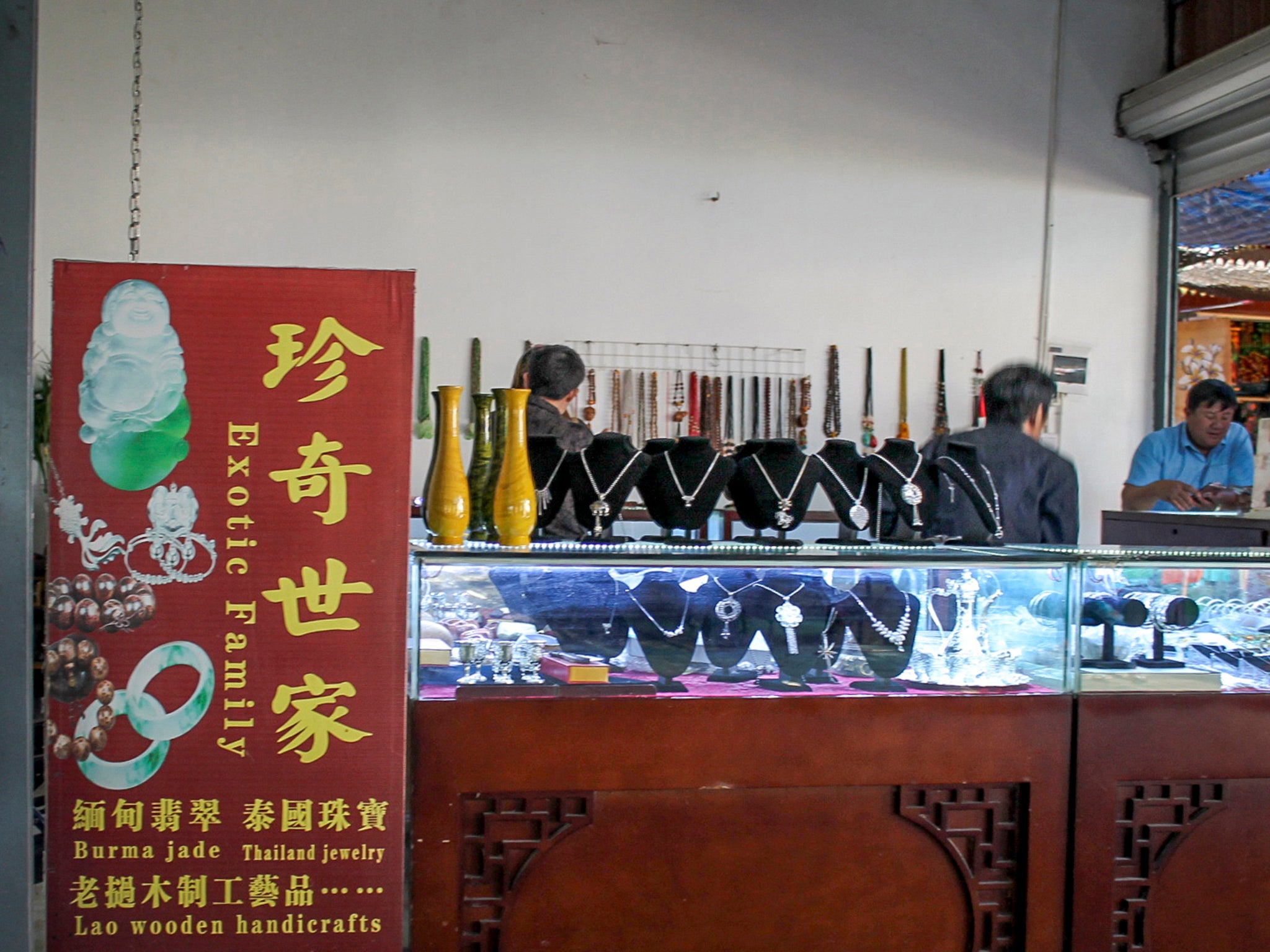
“He won’t stop,” says his wife, Kathy, even after his findings were substantiated, and he was named a Time magazine Hero of the Environment in 2007 for “almost single-handedly raising awareness of the issue of bush meat”, and was told again and again to slow down. His marriage was suffering. Commitment had collided with obsession. “Just part of the furniture” was how Kathy said she’d come to feel, seeing him at the computer, emailing and researching all day. Two personalities jostle inside him, said Dale Peterson, a former collaborator. He was one person around people – combative, cynical, “miserable,” as Peterson put it – and another around animals. That was the Ammann who’d for decades cared for a chimpanzee he’d saved from hunters, or who would stop and discuss even a small bird, he said, “in the most affectionate way.” He was “driven by something larger”.
That intensity building within, he pulled up to the market along the Mekong River, straddling the Lao-Thai border. The door opened, out Chan went, and from the market entrance, Ammann watched her disappear into the stalls.
She was dressed in black. Black hat. Black sunglasses. Black blouse, the top button of which concealed the camera. Ammann wanted us to keep our distance from her at first, knowing the illegal wildlife trade had increasingly receded from public view, just as it once had with bush meat. Sellers these days store their jewellery and medicine in back rooms and hidden drawers that open only for wealthy Chinese customers – which was how Ammann hoped Chan would appear. He followed her into the market.
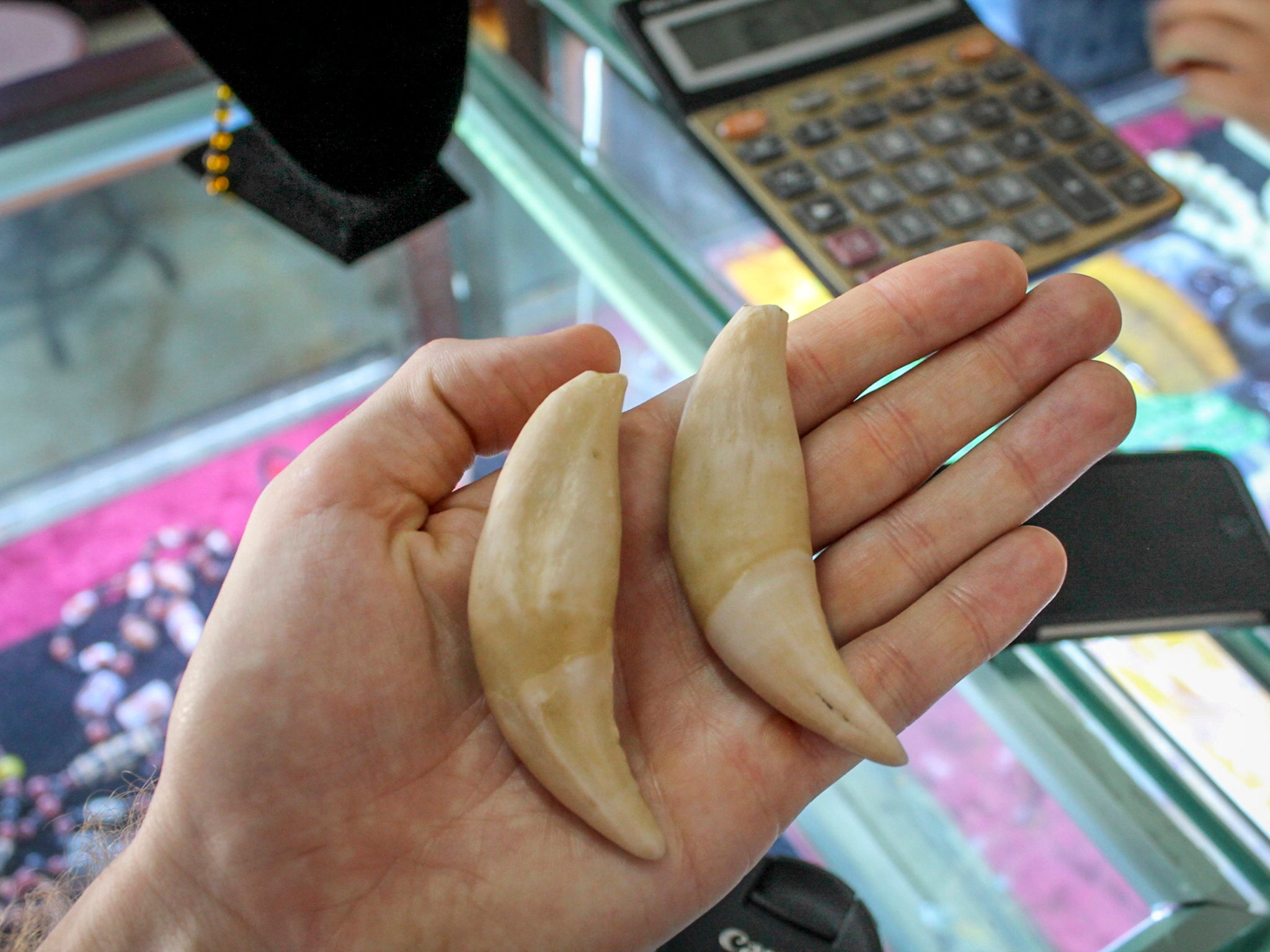
We met her near the back, at the counter of an open-air store named Exotic Family. There, a thin Chinese salesman was drinking tea, wearing rings on both hands, saying, yes, he had tiger parts to sell. We watched him light a cigarette, and out came a small, hollowed tiger bone with intricate carvings: £173.
Also a tiger claw: £173. And two tiger fangs: £1,042. Ammann asked to see more. The man pulled out his phone and sent a contact request on the messaging app WeChat to Chan, who held up the screen for Ammann and myself to see.
She already knew the digital netherworld of wildlife trading, where all she needed to do was enter a few keywords – “jelly” for ivory, “king” for tiger products – to thwart a blanket prohibition on the trade on China’s leading commerce sites. The ban, instituted in 2012, had erased a lot of the listings, but it hadn’t got rid of them all, not with an evolving lexicon of code words and not with social media, where much of the trade has migrated and is more difficult to detect. Elephant-skin powder pills, black-bear gallbladder bile and tiger-bone jewellery: Chan had seen it all. But one rare product didn’t appear on the seller’s WeChat profile. Did he have any tiger skin for sale?
“No tiger skins anymore. You can find them in Vietnam,” he said in Chinese. “In Vietnam, there are more tiger farms.”
“But Laos has a lot of tiger farms, too,” Ammann said. “Tigers in Laos are now protected,” the merchant said.
Ammann looked at him strangely. He knew Laos had vowed to close its tiger farms and stop the trade in wildlife products, but yet here this merchant was, doing just that. So how likely was it that much had changed? The government, after all, had more than two years ago promised a “full audit”, funded by the US Fish and Wildlife Service, to determine the number and origin of the country’s captive tigers. But it had faced numerous delays. And the same tiger breeders the government had previously accused of breaking the law were still involved in the operations, where the tiger population has been fluctuating dramatically, indicating possible trade.
The number of tigers on one farm named Vannaseng surged from 102 to 235, then fell to 111, according to public records and Lao government documents that I reviewed. Another one called Vinasakhone – where Nikhom had worked – reported a sudden loss of 300 tigers in 2017, shedding three-fourths of its population, without ever explaining how that happened. Then a new and massive farm was disclosed by a Vietnamese news outlet in April 2017 in the central Laos town of Lak Sao and as of last year housed 106 tigers. Lao government officials did not respond to repeated requests for comment to discuss these issues.
Ammann, walking away from the stall and the market, believed there were even more tiger enclosures now in Laos, which hadn’t yet been identified. One was rumoured to be right here in the Golden Triangle: He had to find out whether it was true.
We drove several miles, coming to a stop on a desolate dirt road wedged between thatched-roof huts and jungle. Ammann got out of the car. This was where an informant had told him to look. Up ahead, he saw a complex of structures behind a tall wall. “Turn the car around,” Ammann said curtly to the driver. “And turn the engine off.” He reached for his camera and approached the walls, from which hung several signs, praising the facility’s supposed role in conservation.
“Caring rare animals, protect the blue planet,” said one in English.
“Growing with animals and die without them,” said another, also in English.
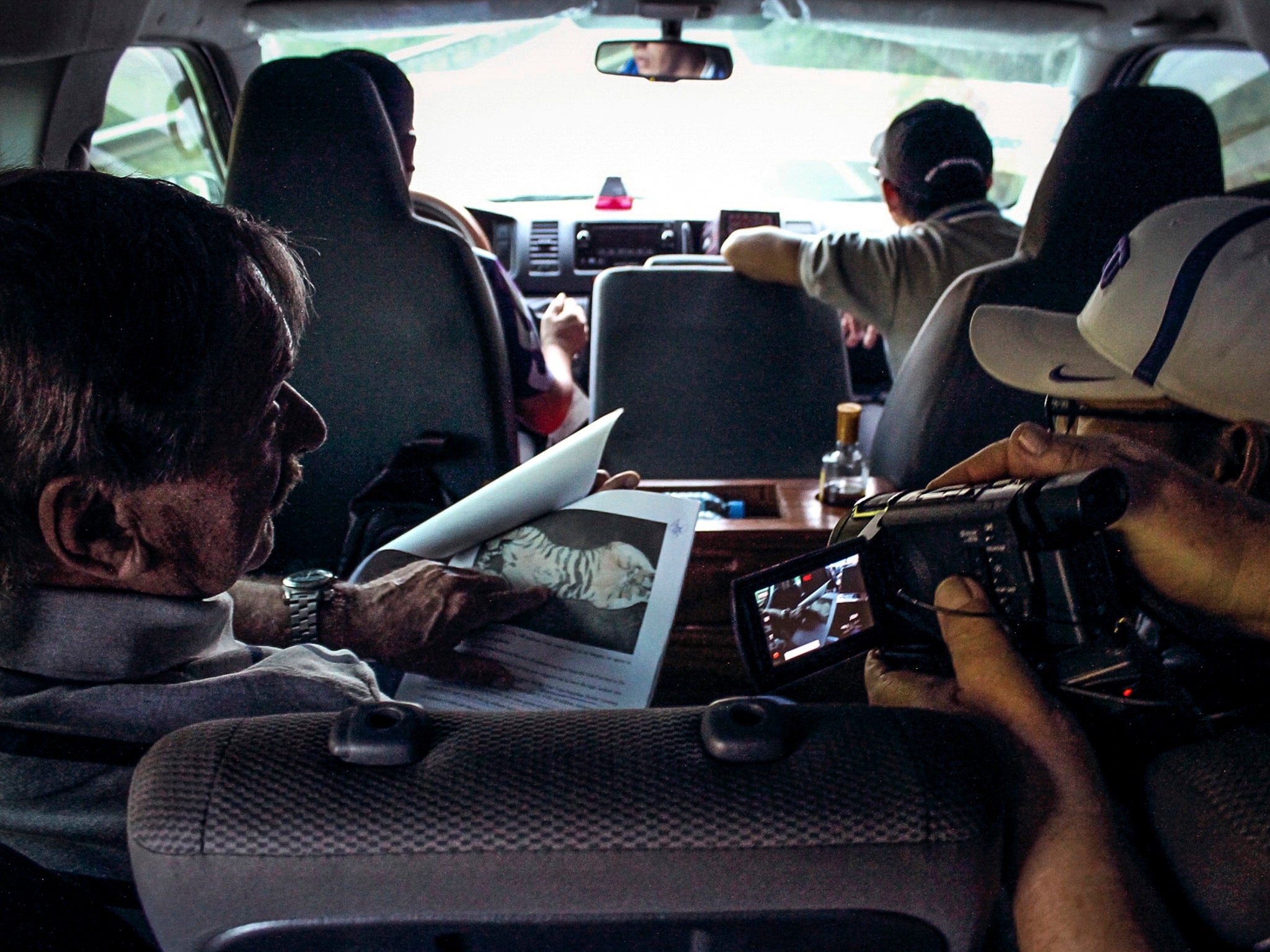
Ammann turned on his camera and held it at his hip. “This must be it,” he said, walking up to the metal gates of a compound said to be controlled by the local criminal syndicate. He started banging. No answer. He banged again, then stuck his camera between a crack in the gates. A young shirtless man came to see what was going on. Ammann decided to bluff his way in.
“Tell him Mr He sent us here,” Ammann directed Chan, who had no idea what he was talking about, but decided to do it anyway. I stood a few feet behind Ammann, waiting for the worker to puncture the cover story and turn us away, but Ammann kept staring at the gate, which was slightly ajar.
Ammann vanished beyond the wall. Chan and I looked at each other briefly, unsure, then followed. A sound that I’d never heard before then came into Ammann’s voice, one of joy and wonder. Around the corner, back in the darkness of one of the structures, stripes were moving.
Even after all this time, seeing tigers up close like this stunned him. They were so big, moving with the latent energy of coiled springs. I ran to another enclosure to photograph whatever was there. Then a tiger paw streaked out through the bars, and I was yelling, jerking my arm away.
The worker wanted us out. He was staring at Ammann, who continued to film. Then I was telling Ammann that we had to leave. The worker was calling his boss again. I didn’t want to be here when he showed up.
One more look, and then his camera was down, and he was in the car, and it was pulling away, and he couldn’t help but shake his head. “Yeah, but Laos is closing down the tiger farms, isn’t it?” he said.
Tiger breeding, killing and selling was going on inside those walls and the man who oversaw much of it was Nikhom
Deeper into the countryside we went, mile after mile, land rising into mountains then plunging into ravines, greens and browns washing by, until there came the river village of Tha Bak. On one side of the road, there was a line of small, cavernous houses. On the other side, a sign announced the resort of Say Namthurn, listing its offerings: golf course, drinking water, zoo.
Ammann got out of the car. He could hear tigers roaring. The sounds were coming from up there, atop a hill shrouded by forest. He reached for his camera.That is where he hoped to find Nikhom. Ammann first heard that name in early 2014. He’d been tracking two tiger cubs that had disappeared before he could buy them from a Lao poacher. His investigation had brought him to central Laos, where Vinasakhone, the country’s biggest farm, stored hundreds of tigers behind concrete walls near the Mekong River.
Its co-owner at the time was a short man named Sakhone Keosouvanh, who hasn’t responded to repeated requests for comment, delivered throughout April by email, messaging services, telephone and certified mail. Unremarkable in appearance but equipped with established government connections, he helped craft Laos’s failed plan to save the country’s last tigers and represented tiger farmers at an international tiger preservation meeting. His farm promoted itself as helping to preserve the tiger population.
Meanwhile, tiger breeding, killing and selling was going on inside those walls, according to Laos government reports I’ve reviewed, and the man who oversaw much of it was Nikhom, who also hasn’t responded to numerous requests for comment.
Nikhom was the one who met with an investigator Ammann had sent into the farm equipped with a hidden camera and the cover story that he was there to enquire about four tigers – three females and one male – for a farm that his “millionaire” Chinese boss wanted to build. “We are happy to sell some for you,” Nikhom had said, according to a transcription of the recording translated into English. The farm, he explained, could transport them to the Chinese border by two means. One was by helicopter – “We use the army helicopter,” he said. “Or we can sell them in pieces.”
“What do you mean ‘pieces’?” the investigator asked, taken aback. “Then the tigers would be dead.”
“That’s what we normally do,” Nikhom responded, before backtracking, seemingly worried about divulging too much. “I think we need to agree to the price first before we talk about other things.”
Over the coming months, the investigator, who spoke with me on the condition of anonymity out of fear for his safety, would often call Nikhom at Ammann’s prompting. The two men soon developed a friendship. The investigator would take Nikhom out for drinks, then secretly record their conversations about women, beer and tigers. “It always cost me,” Ammann later groused. “A lot of alcohol and meals on my invoice.” Soon the investigator was loaning Nikhom money, they were calling each other “brother,” and Nikhom was delving into how tigers were illegally bred, killed and harvested for parts at a level that staggered Ammann.
During the first 10 months of 2014 alone, the farm known as Vinasakhone traded an extraordinary amount – nearly 11 tons – of lion and tiger bone, the former of which is sometimes passed off as tiger bone, according to one government document by the Lao Division of Forest Inspection that I obtained. The report accused the farm of breaking international and local law. But no action could be taken against it.
The farm had “approval from government”, which imposed an extra tax of 2 per cent on all wildlife exports, according to a 2003 Laos customs document that I received from an investigator connected to Thai intelligence. A 2016 confidential survey of the country’s wildlife farms by the Lao Department of Forest Resource Management, which I also reviewed, said the farm wasn’t breeding tigers for “scientific research” – as its permit stated – but for slaughter. “The animal is killed at the farm by knockdown injection, removing all intestines so they keep only the body with skin, bones and meat, covered with plastic sheet for shipment,” the survey said, noting one corpse was believed to go for over £23,000.
Some buyers, when they see the fat tiger and choose it, they only get the weight. For someone who knows ... they will select the thin one. They will consider the bone
“We use this anaesthetic,” was how Nikhom described the process in a conversation with Ammann’s investigator, which The Post had translated. “They start to walk unstably to the left and right and then fall down.”
“How do you kill it?” the investigator asked.
Some have their throats cut. But many clients refuse to buy pierced skin, so “we use the elastic string to tighten its neck ... until it died.”
Afterwards, some buyers want the meat: “Not like cutting the skin of a cow or buffalo, we need to make it an excellent cut, and when we peel the skin, we must be careful not to pierce it.”
“We have to take out all of its meat,” Nikhom said. “When we eat it, it’s just normal to grill or burn it. Its flesh is normal.”
Others want the bones: “They want the one with more bones. Some people, when they see the fat one and choose it, they only get the weight. For someone who knows ... they will select the thin one. They will consider the bone.”
And others only want a dense block of hardened resin known as tiger glue:
“We cut the bone again and break the bone into small pieces, and then we boil again,” Nikhom said. “It will take two to three days to boil it. Then we take out the water and refill water many times, and make it really boil. Then we separate the soup. We take out the boiling water and refill, until the bone is soft and easy to break. Then it means it finishes.”
Boiled or frozen, Ammann realised, dead or alive – tigers had been sold. The operation expanded until 2016, when a new Lao administration came to power and, yielding to international demands, announced in a statement that the farms would close, accusing them of illegally “trading tiger products to international buyers”.
Soon after, 300 of Vinasakhone’s 400 tigers vanished. Then Sakhone, the co-owner, abandoned the farm, beginning a new tiger operation out here, near a border checkpoint notorious for wildlife trafficking. And with him, Ammann heard from his investigator, he had brought along his longtime farm manager, Nikhom.
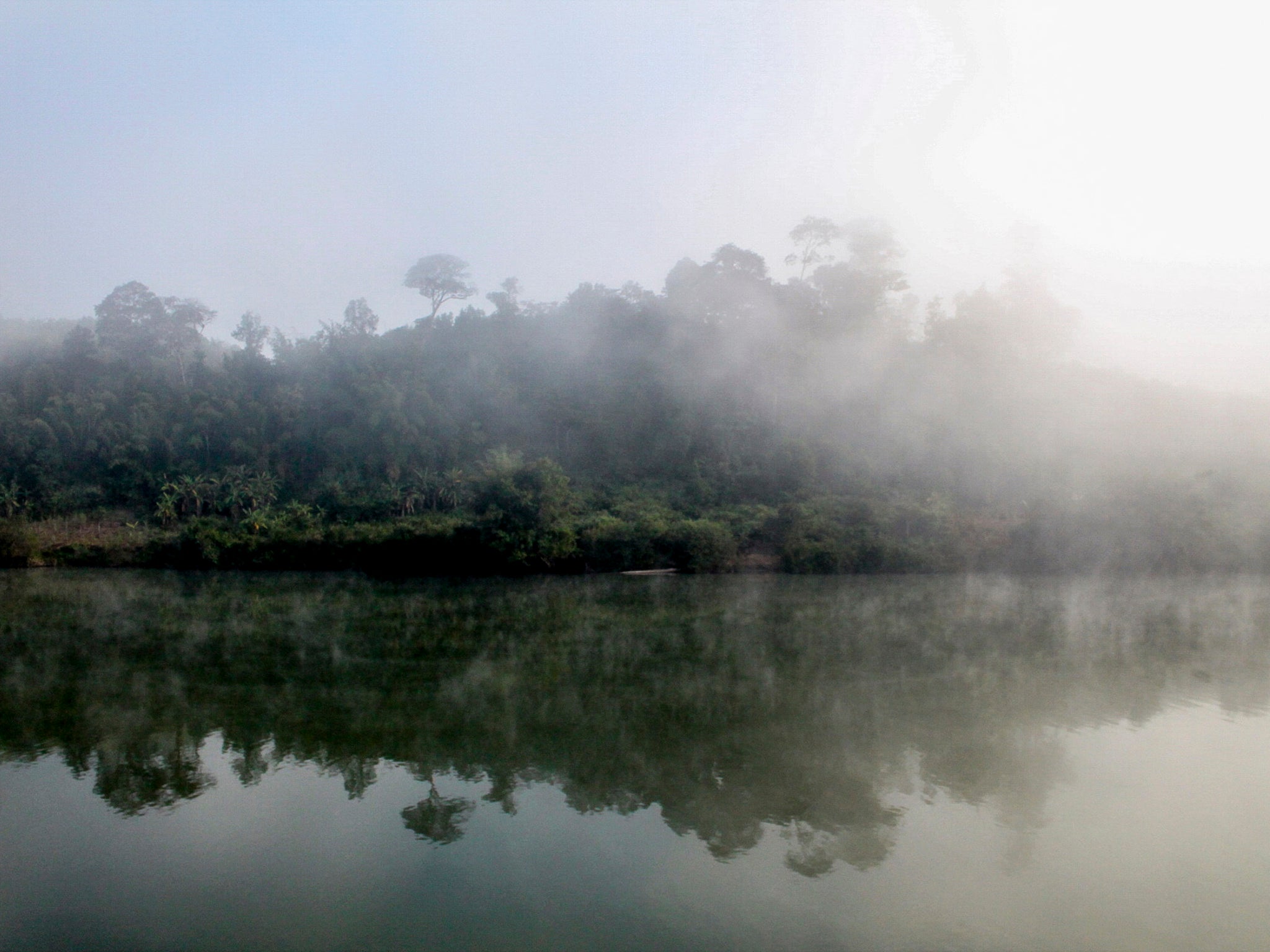
“If Sakhone is here, we have to be careful,” Ammann said. The tiger farmer had connections up and down the border, Ammann believed, and had been so well protected that he’d never faced charges or consequences despite the government allegations against and media scrutiny of his previous operation. Ammann worried about that power. Our intentions for being there couldn’t be discovered.
Thinking it would come off as suspicious to charge up the hill to see the tigers, we walked through a tourist attraction bereft of tourists to the restaurant patio along the river. “There he is,” Ammann said softly, seeing him across the patio. Sakhone was turning to face us, then coming our way, wearing a blue button-down, gold ring and watch, with a Toyota Hilux key dangling from his belt loop.
For so long, Ammann had known Sakhone only as a name on investigative reports and translated transcripts. But now he was gripping Ammann’s hand and smiling broadly. Sakhone took a seat at our table and looked us over. Beers arrived. Ammann, playing the role of tourist, did the talking. Through an interpreter, he asked Sakhone how he’d made his money.
“An import-export company,” Sakhone said.
Ammann asked what he exported.
“Mainly coal,” Sakhone said.
Ammann later told me he’d had the urge to turn on his camera and confront him, just like he had confronted so many others. He wanted to tell him that he’d actually exported tigers – and accuse him of still doing it. “We breed them to get their babies” to sell, Nikhom had recently told Ammann’s investigator, illegal trade an investigative Vietnamese agency has discovered as well.
“The Laotian government is ignoring major trafficking across the border,” an agency official said on the condition of anonymity. Then there was something else: Ammann had learned what he believed was the truth of the missing 300 tigers from Sakhone’s farm. Many had been killed, frozen and trafficked, according to Nikhom and interviews I’ve had with two other people with knowledge of the missing tigers. But Ammann could say none of this, not here, not like this.
Instead, Ammann glanced out into the forests on the other side of the river. They looked so dense. So dark. Surely anything could be out there, even still. “What animals are left in this forest?” he asked, waving a hand towards the trees. “Are there any tigers left?”
Sakhone looked at him for a moment, his face blank. “No,” he finally said. “None of those.”
The tigers weren’t in the forest, but up the hill, on the other side of the resort, moaning all night, a sound that grew louder the next day, as morning gave way to afternoon. Ammann walked along the river and checked his watch: 4pm. It would soon be time to feed the tigers. He settled his camera over his shoulder and started up the hill.
Ammann went past the gates, the view of the river far below him. He kept his gaze fixed on the ramshackle structure on a bed of gravel – chain-link fencing, anchored by poles and patched with blue tarp. The sound of groaning tigers was all around. He went inside. Behind two lines of fencing, on either side of the narrow hallway, were flashes of teeth and slate green eyes. Thirty-five tigers, some weighing 400 pounds, stalked back and forth, back and forth, housed separately in 9-by-12 cages.
Every now and then, a worker would pull open a side door connecting the cages, and in would come another tiger. The two would mate then separate, an act that Ammann and I witnessed three times in less than an hour. Standing here, I realised, the existence of the tiger had been reduced to this: endless pacing, speed breeding and an afternoon meal of raw chicken hurled into its cage at 5pm.
Every now and then, a worker would pull open a side door connecting the cages, and in would come another tiger. The two would mate then separate, an act that Ammann and I witnessed three times in less than an hour
“You couldn’t license a zoo like this anywhere in the world,” Ammann said. After spending hours here – during which we saw only one group of local tourists pay the admission fee of £1.50 – he turned to leave. Then, just outside the front entrance, on the gravel, he saw him. He was sitting at a table strewn with beer bottles – a short man with yellowing teeth, wearing dusty black pants and flip-flops.
From the front of the enclosure, I watched as Ammann walked over to him. How many hours had he listened to the farm manager in the recordings? How many times had he heard him describe the most macabre of details in the most perfunctory of ways? And now here Nikhom was, sitting outside a small concrete house, doing nothing more than drinking and smoking after a day of work.
Ammann and I took seats at his table. Nikhom smiled at the unexpected guests, pouring us beers. This time, however, Ammann did flip on his camera. Then, as his Lao guide interpreted, and I sat watching, he started in with it: “We saw three tiger pairs mating, so in three and a half months, how many babies?”
“So how often do they get tourists?”
“What is going to happen to these tigers?”
Nikhom laughed at the questions, not answering or showing any apparent concern. He offered Ammann more beer. He said he’d worked with tigers since 2007, and this enclosure, which he’d taken over seven months before, was just getting started. These tigers would never leave. Few tourists came, but soon there would be more cages filled with tiger cubs. What he didn’t tell Ammann now, but what he’d told Ammann’s informant: the tigers were profoundly inbred, and few cubs were surviving, only 18 so far.
“So much work needs to be done?” Ammann said, motioning toward the construction, where more cages were being built. Nikhom only laughed again.
Then it was morning. Ammann directed his driver to take him to the capital to present his findings to the local office of CITES, the regulatory authority of international wildlife trade. He stared out the window, as a landscape of jagged mountains dissolved into an endless expanse of arid plains, and thought of Nikhom. He’d always pictured him as a gangster, powerful and menacing, but he hadn’t been that at all. He’d seemed impoverished, in fact, doing what he had to do to survive, just another bit player in a world unable to save itself.
“I feel less strongly about him being a miserable human being than some of the conservationists,” he said. At least Nikhom was who he presented himself to be, Ammann realised, and the self-congratulatory networkers at the wildlife conferences – “backslapping orgies,” he liked to call them – were not.
We stopped at another tiger farm so Ammann could fly the drone over it, and then the city was swelling all around. Soon he was walking inside an expansive building behind thick-trunked trees, carrying a briefcase where he’d stored evidence of his findings. Two new tiger enclosures that didn’t look to him like conservation parks or zoos. Ongoing illegal trade in tiger parts. Signs of expansion at several farms. Allegations that many of the missing 300 tigers had been killed. And proof that the same people who had illegally butchered and sold tigers were still acting as keepers of the animals.
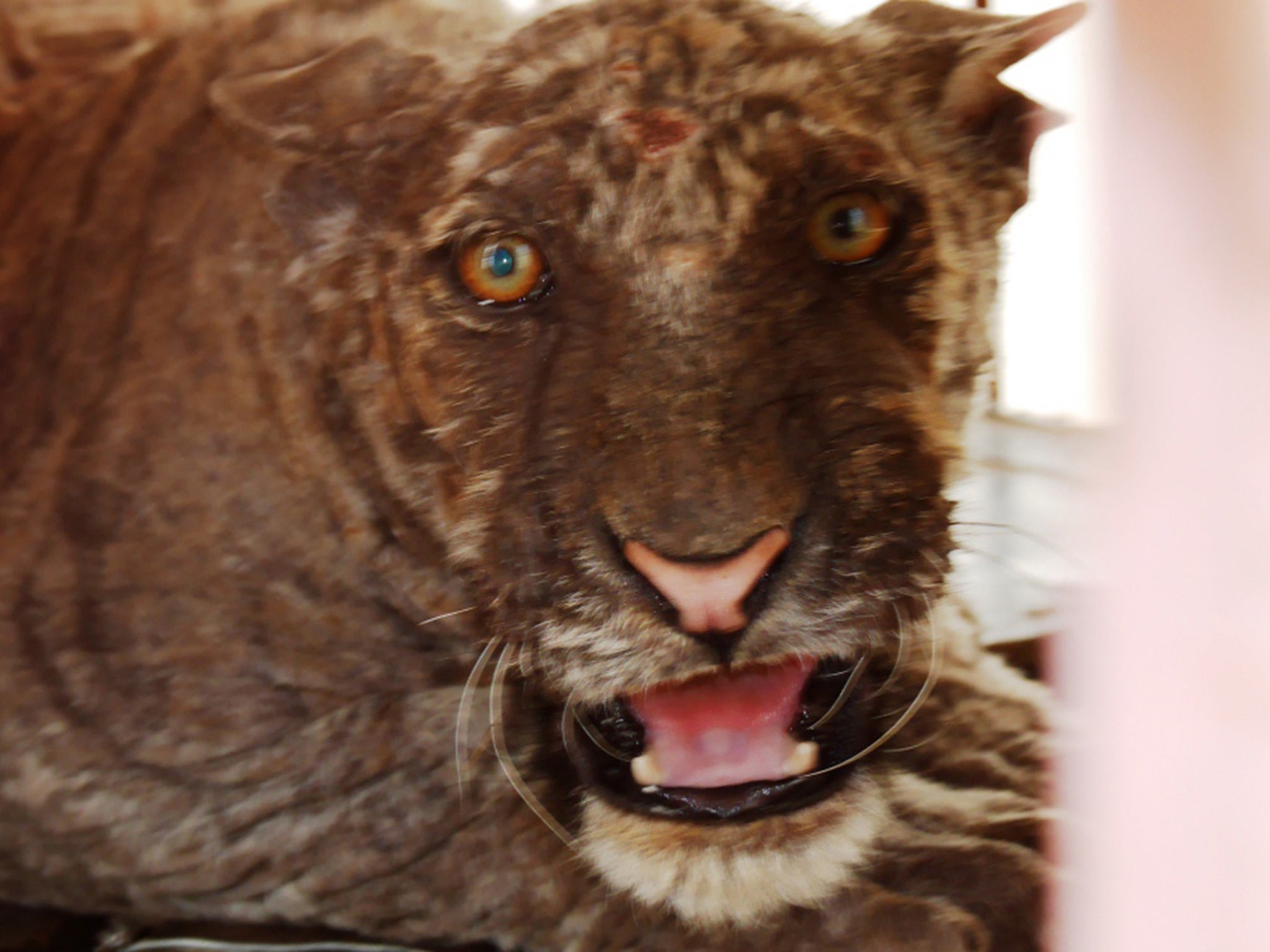
Then he was in a barren conference room, facing a Cites bureaucrat. I sat at the end of the table, watching as the anger Ammann had tried to repress at the resort began to build.
“We know there are two more tiger farms,” Ammann said. “Two new tiger farms! You said you’re closing them down?” On and on he went – “How can your minister say you’re going to close, if now new ones open up?” – but it was no use. Take it up with the bosses in Geneva, he was told. There wasn’t anything the office could do with information brought in like this. “This is our system,” the official said.
Several weeks later, Ammann would again write to every major official. He would tell them of the “active speed breeding” in Laos, the “noncompliance” to its own reforms and that, despite the country’s stated intent to save the tiger, “nothing has really changed or is changing.” He would wait for a response that would never come, then quickly move on to planning the next trip, this one to Kunming, China, to investigate elephant trafficking.
eanwhile, he would send me frequent emails, recommend follow-up pieces, plot ways to obtain video of tiger cubs being born at Sakhone’s resort – maybe this would be the final piece of evidence that got people to listen – and gripe about the response Cites sent me concerning wildlife trade in Laos.
“As with any major change in public policy, it will take time to fully implement and enforce,” the statement said. “While the policy of the Lao government is relatively clear, it is not clear how it is being implemented or enforced.
But at this moment, inside a spare conference room, there was only a Laos official telling him: “I cannot respond.” And what was there to say to that? So Ammann took down his email address. He thanked him for his time. He picked up his briefcase with the proof he’d never been asked to show and walked out.
At the entrance of the building, he stopped for a moment, a strange look on his face. On either side of the doorway was a statue of a tiger. Stripes had been etched into their wooden bodies. Each wore a necklace of fake yellow flowers. Their expressions were frozen in garish snarls. Ammann reached down to touch the head of one of the tigers – an animal once defined by ferocity, now an ornament, lifeless and commodified.
Then he quickly lifted his hand and walked away.
(c) The Washington Post
Join our commenting forum
Join thought-provoking conversations, follow other Independent readers and see their replies
Comments